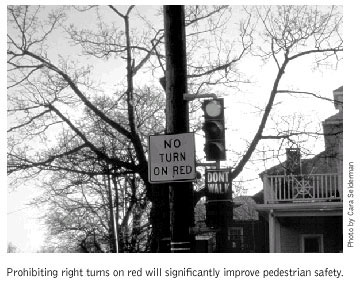44. Right Turn on Red Restrictions
A permissible "Right Turn on Red" (RTOR) was introduced in the 1970s as a fuel savings measure and has sometimes had detrimental effects on pedestrians. While the law requires motorists to come to a full stop and yield to cross street traffic and pedestrians prior to turning right on red, many motorists do not fully comply with the regulations. Motorists are so intent on looking for traffic approaching on their left that they may not be alert to pedestrians on their right. In addition motorists usually pull up into the crosswalk to wait for a gap in traffic, blocking pedestrian crossing movements. In some instances, motorists simply do not come to a full stop.
One significant concern that comes up when RTOR is prohibited is that this may lead to higher RTOG (right turn on green) conflicts when there are concurrent signals. The use of the leading pedestrian interval (LPI) can usually best address this issue (see 41). Where pedestrian volumes are very high, exclusive pedestrian signals should be considered. RTOR should be prohibited where and/or when there are high pedestrian volumes. This can be done with a simple sign posting, although there are some options that are more effective than a standard size sign. For example, one option is a NO TURN ON RED sign with a red ball in the center. This sign may be noticed more easily by an approaching potential RTOR motorist. Another option is a larger 30" by 36" NO TURN ON RED sign which is more conspicuous. For areas where a right turn would be acceptable during certain times, a variable message NO TURN ON RED/blank out sign is an option.

Purpose:
- Increasing pedestrian safety and decreasing crashes at intersections.
Considerations:
- Prohibiting right turns on red is a simple, low cost measure. Together with a leading pedestrian interval, the signal changes can benefit pedestrians with minimal impacts on traffic. They should be done in locations with substantial pedestrian volume and places where children cross.
- Part-time ROTR prohibitions during the busiest times of the day may be sufficient to address the problem.
- Signs should be clearly visible to right-turning motorists stopped in the curb lane at the crosswalk.
Estimated Costs:
$30–$150 per NO TURN ON RED sign. Electronic signs have higher costs.